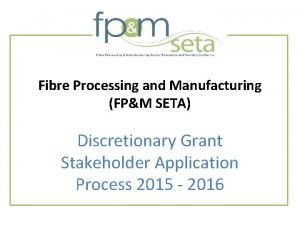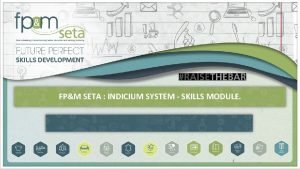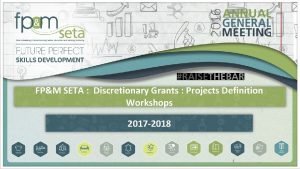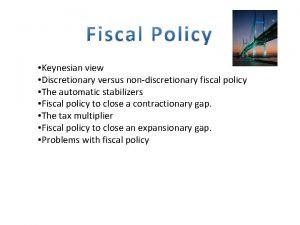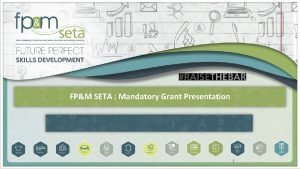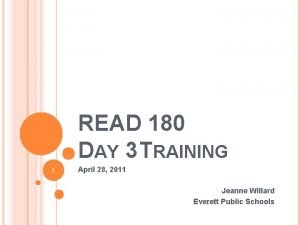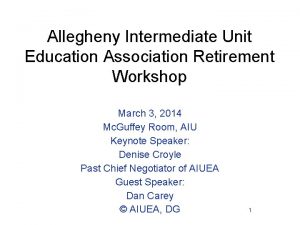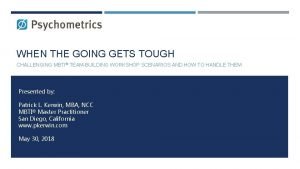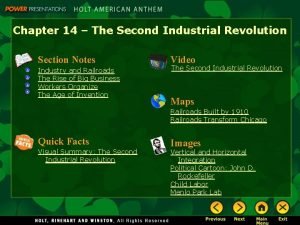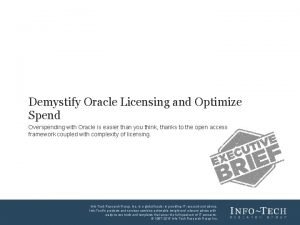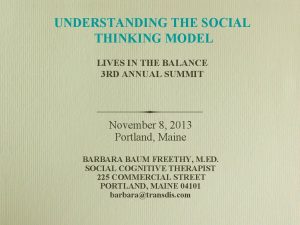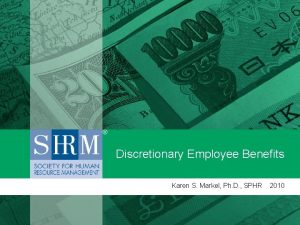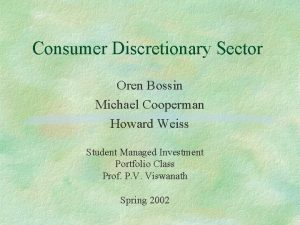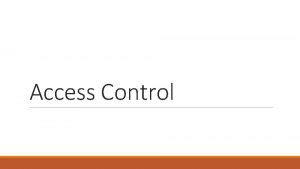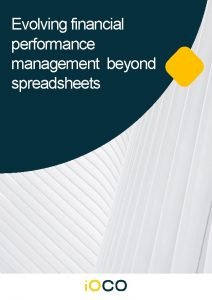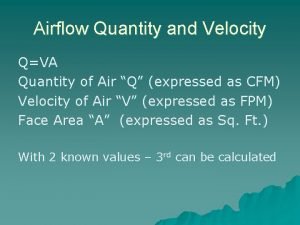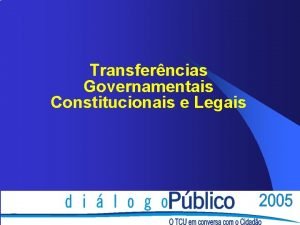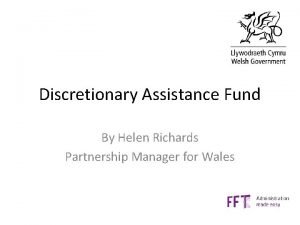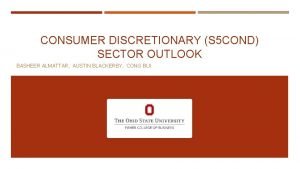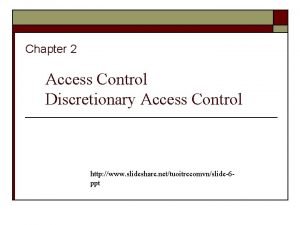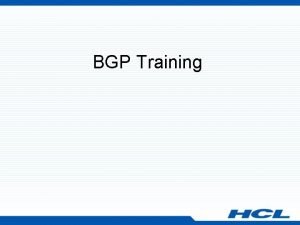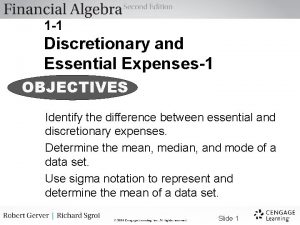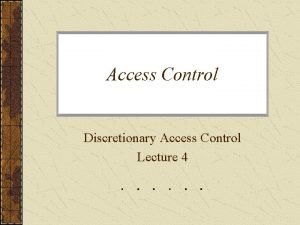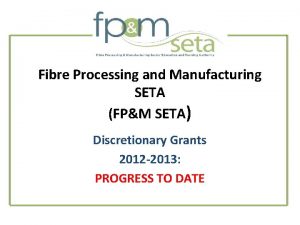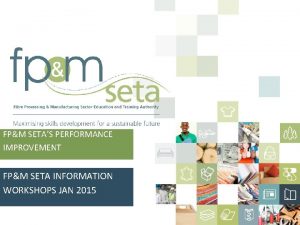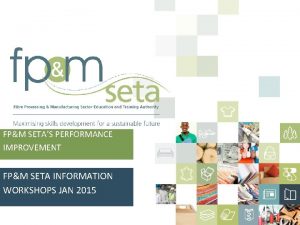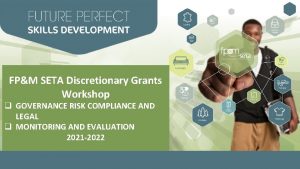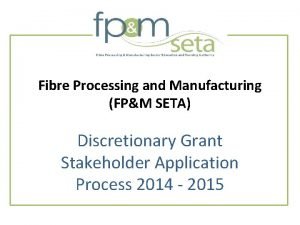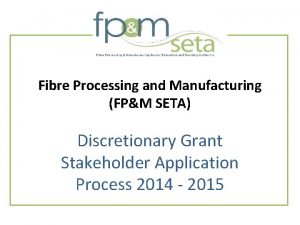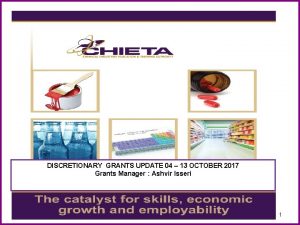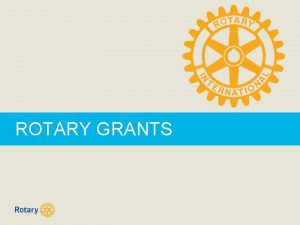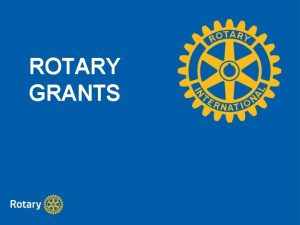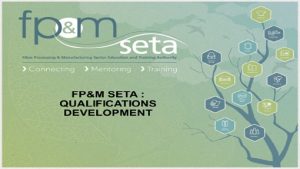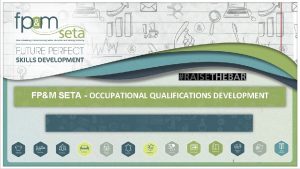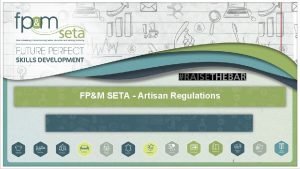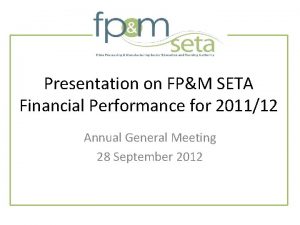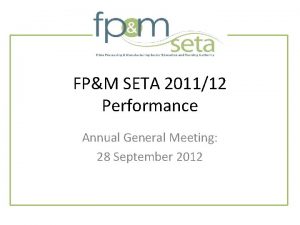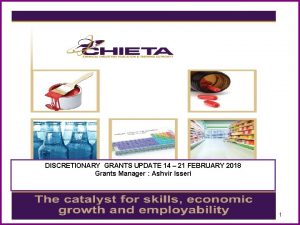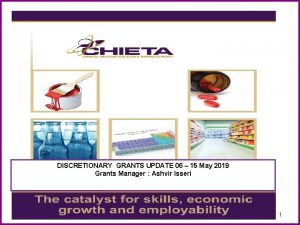FPM SETA Discretionary Grants Projects Definition Workshops 2017
































- Slides: 32

FP&M SETA : Discretionary Grants : Projects Definition Workshops 2017 -2018 1

Content Section 1: Funding Window Process Section 2: Statistical Overview of Applications Section 3: Challenges Section 4: DG Purpose Section 5: App Targets 2017/2018 Section 6: Scarce and Critical Skills Section 7: DG Interventions Costing Apprenticeship Wage Rates Section 8: Contact Details Section 9: Questions and Answers

Funding Window Approval Process • Recap of New business Model • The FP&M Board has approved a New Business Model as from 2014 -2015 onwards: – The main objective: • Increase Efficiencies • Unblock bottlenecks – Decentralising Functions to Regional Offices • Align FP&M SETA to disburse and commit funding in the current Financial Year.

Funding Window Approval Process Discretionary Grant Funding windows opened annually parallel with Mandatory Grant from 16 th January to 30 th April 2017. • Process aligned to DHET reporting requirements • Projects implementation within each respective financial year • No 16/17 funding awards will be implemented in the 17/18 financial year

Funding Window Approval Process • Professional execution of projects, with reduced errors • Reduce inappropriate reporting and accounting challenges • Speed and quality 5

Funding Window Approval Process • Regional recommendations from consolidated online application schedule - Final schedule concluded. • Baseline allocation per learning intervention and category and to be within the FP&M Available Budget. • Ensure fair distribution as per the Levy income per sub-sector.

Funding Window Approval Process • Qualifying Criteria: – DG Verification : Compliance – Legal Documentation – DG Evaluation : WSP/Scarce and Critical Skills Alignment • Decision taken by Board and Exco regarding Approval/Non Approval. • Approved and Unsuccessful Applicants notified in writing of the outcome. 7

Section 2: Statistical Overview of 2016 Applications

Section 3 : Challenges Some of the following Challenges were encountered: • • Invalid documentation (Tax clearance, etc. ) Outside FP&M SETA Scope Incomplete / pending submissions. Failure to meet deadline. Over subscription (Statistics provided) WSP and Pivotal Plan submitted and not approved Projects applied for not linked to approved Pivotal Plan

Challenges • Applications not addressing Scarce and Critical Skills of the sector • Request for changes to funding awarded that ends up affecting targets • Unrealistic applications. i. e. Applying for 500 learners when our budget is for 600 learners 10

Section 4: DG Purpose of Discretionary Grants: To implement projects which assist the SETA in meeting the following: § Sector Skills Plan. § Strategic Plan. §Annual Performance Plan. • As agreed and signed between the Department of Higher Education and the SETA.

Section 5: APP Targets 2017/2018 PERFORMANCE INDICATORS SETA FUNDED TARGETS 4. 1 Number of learners entered into artisan programmes. 350 4. 2 Number of learners completed artisan programmes. 225 4. 3 Number of unemployed learners completed artisan programmes placed in employment. 120 4. 4 Number of unemployed learners entered into Learnership programmes. 1, 800 4. 5 Number of unemployed learners completed Learnership programmes. 1250 4. 6 Number of unemployed learners completed Learnership programme placed in employment 585 4. 7 Number of unemployed learners entered into Bursary programmes 300 4. 8 Number of unemployed learners completed Bursary programmes. 130

APP Targets 2017/2018 PERFORMANCE INDICATORS SETA FUNDED TARGETS 4. 9 Number of unemployed learners completed bursary programme placed in employment. 40 4. 10 Number of learners entered Post -Graduate Bursary programmes. 7 4. 11 Number of learners completed Post -Graduate Bursary programmes. 3 4. 12 Number of partnership agreements established with universities during the year to address scarce and critical skills 3 4. 13 Number of unemployed learners entered Workplace Experience/Internships. 250 4. 14 Number of unemployed learners completed Workplace Experience / Internships. 175

APP Targets 2017/2018 PERFORMANCE INDICATORS 4. 15 Number of unemployed learners entered skills programmes. 4. 16 Number of unemployed learners completed skills programmes. 5. 1 Number of learners who entered AET programmes. 5. 2 Number of learners who completed AET programmes. 5. 3 Number of collaborative partnership agreements signed with youth development organisation. 5. 4 Number of bridging programmes with learners implemented SETA FUNDED TARGETS 850 600 630 440 3 2

APP Targets 2017/2018 PERFORMANCE INDICATORS 6. 1 Number of employed learners entered skills programmes. 6. 2 Number of employed learners completed skills programmes. 6. 3 Number of employed learners entered into Learnership programmes. 6. 4 Number of employed learners completed Learnership programmes. 6. 5 Number of employed learners entered Bursary Programmes. SETA FUNDED TARGETS 2, 050 1, 500 800 560 100

APP Targets 2017/2018 PERFORMANCE INDICATORS SETA FUNDED TARGETS 6. 6 Number of employed learners completed Bursary Programmes. 40 6. 7 Number of unemployed learners entered Work-Integrated Learning Programmes from TVETs. 400 6. 8 Number of unemployed learners completed Work-Integrated Learning Programmes from TVETs. 275 6. 9 Number of unemployed learners entered Work-Integrated Learning Programmes from HETs. 200 6. 10 Number of unemployed learners completed Work-Integrated Learning Programmes from HETs. 150

APP Targets 2017/2018 PERFORMANCE INDICATORS 7. 1 Number of Co-operatives Supported 7. 1 Number of Small Business Supported 7. 1 Number of NGOs Supported 7. 1 Number of CBO Supported 7. 1 Number of NLPE Supported 7. 1 Number of Trade Unions Supported 7. 2 Number of rural development projects supported. SETA FUNDED TARGETS 20 20 3 3 5 2 20

Section 6: Scarce & Critical Skills • Skills gaps within FP&M organisations • Deficiencies of specific knowledge, experience or competencies • Influence level of effectiveness • Hinder business growth

Scarce & Critical Skills The Scarce and Critical Skills List : • Address skills development imperatives • Ensure alignment to the Human Resource Development Strategy • Inform SETA funding and training facilitation according to industry needs

Scarce & Critical Skills • Addressed through interventions and short courses • Strategic management, leadership skills, industrial relations, financial management, train-the-trainer, supervisory development etc.

Scarce & Critical Skills OCCUPATIONAL CATEGORY OCCUPATION (SPECIALISATION) Managers Human resources, training and education, logistics, production and quality management; supervisors, small business owner/manager Professionals Work study officers, designers (including fashion and graphic designers), industrial and chemical engineers, forest scientists and sales and marketing specialists, ETD practitioners, editors Technologists and technicians (specializing in different disciplines), fitters and turners, printing machinists, patternmakers and mechanics, computer network technicians, electricians, production / operations supervisor (manufacturing) Technicians and trades workers SCARCE Insufficient number of qualified and experienced people in specific occupations

Scarce & Critical Skills OCCUPATIONAL CATEGORY OCCUPATION (SPECIALISATION) Community and personal service Fire fighters (forestry) workers Clerical and administrative workers Cost clerks, production coordinators and environmental practices inspectors; Machinery operators and drivers Elementary workers Machine operators and mobile plant operators, machinists, upholsterers, cabinet makers, footwear closing production machine operator, leather processing machine operator, textile / leather / material cutting machine operator, sewing machine operator Sawmill or timber yard workers, harvesters and printing table workers, pest or weed controllers, textile, clothing and footwear factory worker

Scarce & Critical Skills • The list is available from the FP&M SETA website: www. fpmseta. org. za • NB: Scarce and Critical Skills take priority over all other intervention applications. 23

Section 7 : DG Interventions Costing Intervention Duration Learnerships 12 Months Apprenticeships 3 - 4 Years Section 13 Cost ( VAT Zero Rated) Employed 18. 1 R R 50. 00 Unemployed 18. 2 20, 000. 00 R per year for three years R 50. 00 Per Trade Test Apprenticeships Section 28 None R 5, 000. 00 25, 000. 00 per year for three years

DG Interventions Costing Intervention Duration Cost ( VAT Zero Rated) Employed & Unemployed R Bursaries 2 - 4 Years 35, 000. 00 Undergraduates Postgraduates R 35. 000. 00 per year for three study years R 50. 00 per year for two study years Technical R 7200. 00 (minimum 45 credits) Skills Programmes Occupational - Unemployed 18. 2 3 - 9 Months R 7200. 00 (minimum 45 credits) Occupational - Employed 18. 1 (RPL) R 5, 000. 00

DG Interventions Costing Intervention Work Experience Duration 6 - 12 Months Cost ( VAT Zero Rated) 6 Months R 12 Months 15, 000. 00 R 30, 000. 00 Learner Allowance for 6 Months Internships Maximum R 15 000. 00 6 - 12 Months Learner Allowance for 12 Months Maximum R 30 000. 00 Learner Allowance for 18 Months WIL 18 Months AET 12 Months Per Level Maximum R 45 000. 00 R 3, 000. 00

Section 6: Apprenticeship Wage • Printing, Packaging and Textile Sector Specific Wage Rates as of 2016/2017: Minimum Wage Scales for Apprentices - Printing & Packaging 2016 2017 6. 5% Increase Daily Weekly Monthly PHASE 1 & 2: R 1, 117. 22 R 72. 62 R 1, 189. 84 R 237. 97 R 1, 189. 84 R 5, 152. 00 PHASE 3: R 1, 246. 28 R 81. 01 R 1, 327. 29 R 265. 46 R 1, 327. 29 R 5, 747. 16 PHASE 4: R 1, 710. 11 R 111. 16 R 1, 821. 27 R 364. 25 R 1, 821. 27 R 7, 886. 09

Apprenticeship Wage Minimum Wage Scales for Apprentices -Textile Sector 2016 hourly 2017 8% Hourly Daily Weekly Monthly First Year R 25. 93 R 2. 07 R 28. 00 R 252. 04 R 1, 260. 20 R 5, 460. 86 Second Year R 28. 50 R 2. 28 R 30. 78 R 277. 02 R 1, 385. 10 R 6, 002. 10 Third Year R 34. 00 R 2. 72 R 36. 72 R 330. 48 R 1, 652. 40 R 7, 160. 40 28

DG Purpose: Tranche Splits per Intervention

• Johannesburg – William Malema – 011 -403 1700 – William. M@fpmseta. org. za • Cape Town – Leigh Hayes– 021 -462 0057 – Leigh. H@fpmseta. org. za • Durban – Lungile Shabangu– 031 -7024482 – Lungile. S@fpmseta. org. za HEAD OFFICE REGIONAL OFFICES Section 8: Contact Details • Projects – Chereece Samuels-Balkisson – 011 403 1700 – Chereece. B@fpmseta. org. za

Section 9: Questions and Answers 31

Thank You
 Fpm seta
Fpm seta Agriseta indicium
Agriseta indicium Discretionary grants definition
Discretionary grants definition Discretionary and non discretionary fiscal policy
Discretionary and non discretionary fiscal policy Fp&m seta contact details
Fp&m seta contact details Read 180 workshops
Read 180 workshops Psea retirement calculator
Psea retirement calculator Mbti activities for small groups
Mbti activities for small groups Cramped workshops set up in shabby tenement buildings
Cramped workshops set up in shabby tenement buildings Workshops glutenvrij
Workshops glutenvrij Can665.com
Can665.com Oracle licensing workshops
Oracle licensing workshops Michelle garcia winner double interview
Michelle garcia winner double interview Nature explore workshops
Nature explore workshops Icef toronto
Icef toronto Canadian bioinformatics workshops
Canadian bioinformatics workshops Canadian bioinformatics workshops
Canadian bioinformatics workshops Canadian bioinformatics workshops
Canadian bioinformatics workshops Canadian bioinformatics workshops
Canadian bioinformatics workshops What are discretionary employee benefits
What are discretionary employee benefits Consumer discretionary buying behavior
Consumer discretionary buying behavior Discretionary access control definition
Discretionary access control definition Fpm landscapes
Fpm landscapes Financial performance management fpm
Financial performance management fpm Biological safety cabinet vs fume hood
Biological safety cabinet vs fume hood Q = va
Q = va Tabela de coeficiente do fpm
Tabela de coeficiente do fpm Daf fund wales
Daf fund wales Consumer discretionary sector outlook
Consumer discretionary sector outlook Discretionary access
Discretionary access Well-known discretionary attributes
Well-known discretionary attributes Financial algebra discretionary and essential expenses
Financial algebra discretionary and essential expenses Advantages of discretionary access control
Advantages of discretionary access control
